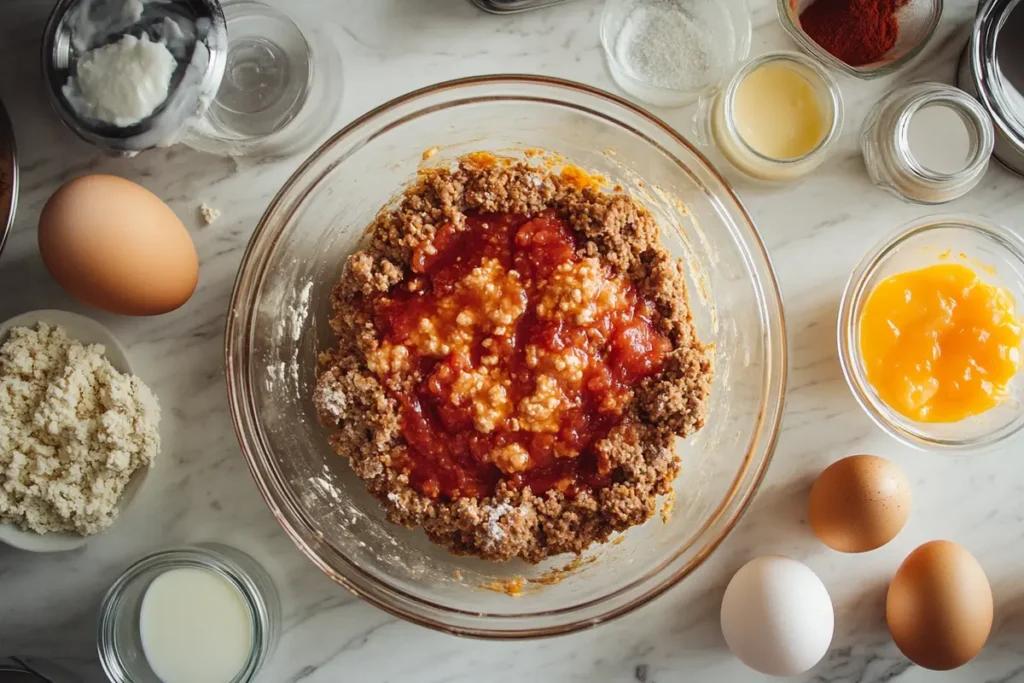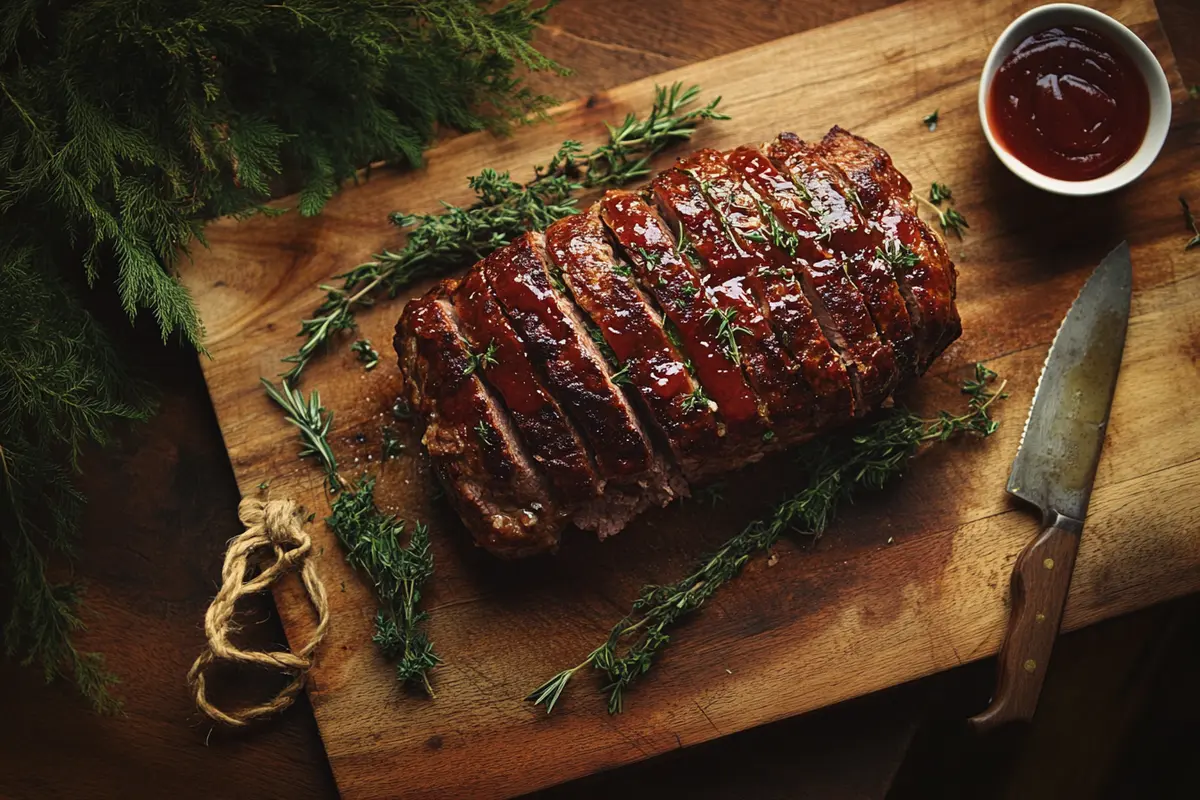Classic Meatloaf Recipe: The Ultimate Guide to Perfecting a Timeless Dish
Meatloaf is a quintessential comfort food that has graced family dinner tables for generations. From its origins to its modern-day variations, this dish continues to bring warmth and satisfaction to countless homes. With its moist, tender interior and beautifully caramelized glaze, a classic meatloaf recipe has all the makings of a beloved culinary staple.
In this guide, we’ll explore the secrets behind creating a perfect meatloaf, discuss creative variations, and provide tips for elevating this traditional dish. Whether you’re a seasoned cook or a beginner in the kitchen, this article will give you everything you need to make a meatloaf that’s flavorful, foolproof, and worthy of seconds. Ultimately, you’ll master the art of preparing this timeless comfort food with ease and confidence.
Understanding What Makes the Best Classic Meatloaf Recipe
Understanding the Basics
At its core, a classic meatloaf recipe is all about balance. Thus, the ideal loaf has a moist interior, a crisp crust, and flavors that harmoniously blend together. Achieving this balance depends on three critical components: texture, flavor, and crust.
For example, texture is crucial. Meatloaf should hold its shape but remain tender. A combination of ground beef, breadcrumbs, and milk helps achieve that delicate crumb. Eggs act as a binder, ensuring everything stays together without becoming dense or dry.
Flavor is another key element. In addition, this dish is more than just meat. Aromatics like onions, garlic, and herbs, along with seasonings like salt, pepper, and Worcestershire sauce, amplify its savory profile. Therefore, don’t shy away from umami-packed ingredients like mushrooms or even a hint of fish sauce for depth.
Finally, crust completes the trifecta. A beautifully browned, slightly caramelized crust is the crowning glory of a great meatloaf. While a ketchup-based glaze is a classic choice, alternatives like BBQ sauce or a brown sugar mixture can provide a sweet-savory twist.
Essential Ingredients for Classic Meatloaf
However, while every cook adds their unique spin, certain ingredients are non-negotiable in a traditional recipe:
- Protein: Most recipes use ground beef, but blends with pork or veal can add richness.
- Binders and Fillers: Breadcrumbs soaked in milk create tenderness, while eggs provide structure.
- Seasonings: Freshly chopped onions and garlic, combined with herbs like thyme or parsley, are classic additions. Worcestershire sauce and Dijon mustard offer a punch of flavor.
- Glaze: Ketchup, mustard, and brown sugar combine for a tangy-sweet topping that complements the savory meat.
By mastering these elements, you’ll be well on your way to crafting a meatloaf that’s as satisfying to make as it is to eat. Next, we’ll dive into the step-by-step process of bringing this dish to life.
Step-by-Step Guide to Perfecting Your Classic Meatloaf Recipe

Preparing Ingredients for Homemade Meatloaf
The magic of a classic meatloaf recipe starts with gathering fresh and simple ingredients. First and foremost, select high-quality ground beef with a moderate fat content—80/20 is ideal for achieving a moist texture. After that, soak breadcrumbs in milk, which helps keep the loaf tender and moist. When combined, this mixture forms the backbone of the meatloaf’s structure, ensuring the perfect balance of flavor and texture.
In addition, chop onions finely to ensure they blend seamlessly into the loaf. If you want to add extra texture, consider incorporating grated carrots or celery for a subtle crunch. Meanwhile, seasonings like salt, pepper, and Worcestershire sauce elevate the flavor profile, giving the dish its savory, nostalgic taste.
How to Shape and Glaze Your Classic Meatloaf
Once your ingredients are combined, the next step is shaping the meatloaf. Gently mix the ingredients using your hands or a spatula—overmixing can make the loaf tough. Shape the mixture into an even loaf on a baking sheet or press it into a loaf pan for uniform cooking.
A glaze is a defining feature of a classic meatloaf recipe. Mix ketchup with a touch of mustard and brown sugar for a tangy-sweet finish. Spread this glaze evenly over the top of the loaf before it goes into the oven. For an extra glossy finish, apply a second layer midway through baking.
Baking Your Traditional Meatloaf to Perfection
First, preheat your oven to 350°F (175°C) and bake the meatloaf for about 55-60 minutes. To ensure even cooking, place the loaf in the center of the oven, where the heat is most consistent. Additionally, use a meat thermometer to check for doneness—the internal temperature should reach 160°F (71°C) for safe and juicy results.
Once baked, let the meatloaf rest for 10 minutes after removing it from the oven. This step is crucial because it allows the juices to redistribute, making every slice moist and flavorful. Finally, serve your perfectly baked meatloaf with a side of creamy mashed potatoes for the ultimate comfort meal.
Variations of the Classic Meatloaf Recipe
Cheeseburger Meatloaf
To add a fun twist, transform your classic meatloaf recipe into a cheeseburger-inspired dish. Incorporate shredded cheddar cheese directly into the meat mixture or layer it as a filling. Additionally, for extra indulgence, wrap the loaf in bacon before baking. The result? A melty, savory meatloaf that feels like a comfort-food revelation.
Cheeseburger Twist on a Classic Meatloaf
If you love a touch of sweetness, a brown sugar glaze is the perfect addition. Mix brown sugar with ketchup and a dash of apple cider vinegar. Spread this mixture at the base of your loaf pan before adding the meat mixture. When baked, the glaze caramelizes, creating a sweet-savory crust that pairs beautifully with pickles or slaw.
Air Fryer Meatloaf
For a modern twist, try cooking meatloaf in an air fryer. This method gives you a perfectly crispy crust in less time. The circulating hot air cooks the loaf evenly, and brushing the glaze during the final minutes adds a delectable finish. Air fryer meatloaf is a quick and easy option for busy weeknights.
For a variation on meatloaf without eggs, check out Meatloaf Recipe Without Eggs for inspiration on alternative binders like mashed potatoes or flaxseed.
Expert Tips for the Perfect Meatloaf Every Time
Common Mistakes to Avoid
Even with the best intentions, mistakes can turn a classic meatloaf recipe into a disappointment. One common error is overmixing the meat mixture. While it’s tempting to combine ingredients thoroughly, overworking the meat can lead to a dense, tough loaf. Instead, gently mix until just combined.
Another pitfall is skipping the resting stage. Allowing the meatloaf to rest for 10-15 minutes after baking is essential for locking in juices and making each slice tender.
Lastly, avoid a soggy crust by baking the meatloaf on a shallow pan rather than in a deep loaf pan. This method promotes better airflow and ensures an evenly caramelized crust.
Secrets to Moist and Flavorful Loaf
A moist and flavorful classic meatloaf recipe starts with high-quality ingredients and simple tricks. Soaking breadcrumbs in milk prevents the loaf from drying out while adding depth to its flavor.
For an umami boost, incorporate Worcestershire sauce, soy sauce, or finely chopped mushrooms. Fresh herbs like parsley or thyme add a hint of brightness, while grated vegetables like carrots or zucchini contribute both moisture and subtle sweetness.
To elevate the crust, brush the loaf with glaze twice—once before baking and again in the last 10 minutes. This ensures a rich, sticky topping that contrasts beautifully with the tender interior.
For more great tips and techniques, check out How Important Is the Egg in Meatloaf?, which dives into key ingredient substitutions and their effects on texture and flavor.
Serving Suggestions and Pairings
Classic Sides for Meatloaf
Every classic meatloaf recipe deserves equally delicious side dishes. Creamy mashed potatoes are the ultimate pairing, soaking up the savory juices for a truly comforting bite. Add steamed green beans, roasted carrots, or a fresh garden salad to balance the richness of the meatloaf.
For a twist, serve the meatloaf with cheesy potato gratin or tangy coleslaw for a fresh crunch. Another great option is hearty buttered noodles, which pair wonderfully with the savory flavors of the dish.
Creative Ways to Use Leftovers
Don’t let leftover meatloaf go to waste! Transform slices into meatloaf sandwiches with toasted bread, lettuce, and a dollop of extra glaze. For a comforting breakfast, dice leftover meatloaf and mix it into a hash with potatoes and onions.
You can also crumble meatloaf into a hearty pasta sauce or add it to a quesadilla for a fun twist on Tex-Mex flavors. The possibilities are endless!
If you’re searching for more creative comfort food ideas, browse our Crock-Pot Chicken Tenders Recipes for inspiration.
FAQs About Classic Meatloaf
How Do You Keep a Traditional Meatloaf from Falling Apart?
One of the most common problems cooks face with a classic meatloaf recipe is the loaf falling apart. The key, however, lies in the binder. Ingredients like breadcrumbs, eggs, and milk work together to hold the loaf together.
To ensure your meatloaf doesn’t crumble, measure your binders carefully. Generally, one egg per pound of meat and about ½ cup of breadcrumbs works best.
What are the best substitutes for breadcrumbs in meatloaf?
If you’re out of breadcrumbs or need a gluten-free option, don’t worry—there are plenty of substitutes! Crushed crackers, rolled oats, or almond flour can work as effective binders. Even cooked rice or mashed potatoes can add structure to your meatloaf while keeping it moist.
For more unique ideas, check out recipes that highlight creative binders like flaxseed or cornmeal. These swaps are perfect for experimenting with textures and flavors while sticking to the classic formula.
Can I freeze meatloaf? How do I reheat it properly?
Yes! Meatloaf freezes beautifully, whether raw or cooked. To freeze, wrap it tightly in plastic wrap and aluminum foil or place it in an airtight container. When you’re ready to cook, thaw it in the fridge overnight and bake as usual.
If your meatloaf is already cooked, reheating is easy. Slice the loaf, wrap the pieces in foil, and warm them in the oven at 300°F (150°C) for about 15-20 minutes. Adding a small amount of broth or water to the foil prevents dryness.
What’s the best meat-to-fat ratio for a flavorful meatloaf?
The meat-to-fat ratio plays a big role in achieving the perfect classic meatloaf recipe. Aim for an 80/20 ratio, as the fat helps keep the loaf juicy while providing rich flavor. Leaner meats like ground turkey or chicken may need added moisture from ingredients like grated zucchini or a touch of olive oil.
Conclusion and Final Thoughts
A classic meatloaf recipe is more than just a comforting dish—it’s a timeless family favorite that brings people together. From mastering the perfect texture to experimenting with creative variations, making meatloaf is a rewarding experience that offers endless opportunities to customize and enjoy.
By following the tips and techniques shared in this guide, you’ll be well-equipped to create a meatloaf that’s juicy, flavorful, and unforgettable. Pair it with classic sides like mashed potatoes or explore inventive ways to use leftovers for maximum enjoyment.
Whether you’re preparing a nostalgic meal for your family or hosting a cozy dinner, this classic meatloaf recipe is sure to be a hit. So roll up your sleeves, preheat that oven, and let the magic of meatloaf fill your kitchen with warmth and delight!
The History and Evolution of the Classic Meatloaf Recipe
Roots in European Cuisine
The classic meatloaf recipe we know today has its origins in European cooking, specifically in Germany and Scandinavia. These early versions, known as “scrapple” or “hackbraten,” were made with scraps of meat combined with grains or breadcrumbs to stretch the dish for larger families. The technique ensured no part of the animal went to waste, making it a practical and sustainable choice.
As immigrants brought their recipes to America in the 19th century, meatloaf began to adapt to local ingredients and preferences. The addition of ketchup as a glaze became a hallmark of American-style meatloaf, giving it the sweet-savory flavor we associate with comfort food today.
Modern Variations and Trends
Over the years, the classic meatloaf recipe has evolved to suit changing tastes and dietary needs. Chefs and home cooks alike have experimented with everything from vegetarian versions made with lentils and mushrooms to gluten-free options using almond flour or oats.
The air fryer and instant pot have also revolutionized the way meatloaf is cooked, making it quicker and easier than ever. Despite these modern innovations, the heart of the recipe—a flavorful, hearty loaf—remains the same.
By understanding the dish’s rich history, we can appreciate why the classic meatloaf recipe has stood the test of time, evolving into a beloved staple in kitchens worldwide.
Tips for Customizing Your Classic Meatloaf Recipe
Adding a Personal Touch
One of the best things about the classic meatloaf recipe is how easy it is to customize. If you love bold flavors, try adding diced jalapeños, smoked paprika, or a splash of hot sauce to the meat mixture. For a cheesy twist, stuff the center of your loaf with shredded cheddar or mozzarella.
If you prefer a lighter version, swap ground beef for ground turkey or chicken, and add grated zucchini to keep the loaf moist. For a Mediterranean-inspired flavor, include sun-dried tomatoes, feta cheese, and oregano.
Experimenting with Glazes
The glaze is where creativity can truly shine. While a ketchup-based glaze is a classic, other options like BBQ sauce, honey mustard, or even a balsamic reduction can elevate your meatloaf to the next level. For a smoky-sweet flavor, mix maple syrup with a touch of chipotle powder.
Feel free to let your pantry guide you—this dish is a great canvas for experimenting with different flavors and textures. No matter how you customize it, the classic meatloaf recipe remains a timeless, adaptable dish that can reflect your unique culinary style.
Nutritional Information (Per 100g)
Below is the approximate nutritional content of a classic meatloaf:
| Nutrient | Amount |
|---|---|
| Calories | 230 kcal |
| Protein | 16 g |
| Fat | 15 g |
| Carbohydrates | 9 g |
| Fiber | 1 g |
| Sodium | 480 mg |
| Sugar | 3 g |

